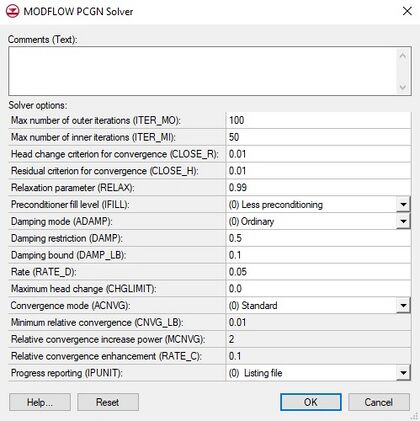GMS:PCGN Package: Difference between revisions
From XMS Wiki
Jump to navigationJump to search
No edit summary |
No edit summary Tag: Manual revert |
||
| (31 intermediate revisions by 4 users not shown) | |||
| Line 1: | Line 1: | ||
{{MODFLOW Links}} | {{MODFLOW Links}} | ||
The PCGN package or Preconditioned Conjugate Gradient Solver with Improved Nonlinear Control is one of the solvers available for MODFLOW-2005. | The PCGN package, or Preconditioned Conjugate Gradient Solver with Improved Nonlinear Control, is one of the solvers available for MODFLOW-2005. Using the PCGN solver a specific GMS MODFLOW executable (mf2k5_..._parallel.exe) can be run with parallel processing on a single machine (though not across multiple machines on a network) greatly reducing run time. | ||
For more information on this solver see the USGS documentation | The ''MODFLOW PCGN Solver'' dialog has the following options: | ||
* ''Comments (Text)'' – Allows up to 199 characters. | |||
* ''Max number of outer iterations (ITER_MO)'' – For nonlinear problems, this variable must be set to some number greater than one, depending on the problem size and degree of nonlinearity. If set to 1, then the solver assumes that the problem is linear and the input requirements are greatly truncated. | |||
* ''Max number of inner iterations (ITER_MI)'' – Set to some number greater than one, depending on the matrix size, degree of convergence called for, and the nature of the problem. | |||
* ''Head change criterion for convergence (CLOSE_R)'' – If set to 1 then the problem will be linear. If set to be greater than 1 then it will be a nonlinear problem. | |||
* ''Residual criterion for convergence (CLOSE_H)'' – Used as an alternate stopping criterion for the Picard iteration needed to solve a nonlinear problem. | |||
* ''Relaxation parameter (RELAX)'' – Relaxation parameter for the modified incomplete Cholesky (MIC) preconditioner. Value can be between 0 and 1. Generally a value between 0.9 and 0.99 is advised for most problems. | |||
* ''Preconditioner fill level (IFILL)'' – Fill level of the MIC preconditioner. Preconditioners with fill levels of 0 and 1 are available. | |||
** (0) Less preconditioning | |||
** (1) More preconditioning | |||
* ''Damping mode (ADAMP)'' – Defines the mode of damping applied to the linear solution. | |||
** (0) Ordinary – A constant value of damping parameter θ = DAMP will be used. | |||
** (1) Adaptive – Changes the damping parameter θ in response to the difficulty the nonlinear solver encounters in solving a given problem. | |||
** (2) Enhanced – The value of θ is increased (but never decreased) provided the Picard iteration is proceeding satisfactorily. | |||
* ''Damping restriction (DAMP)'' – Restricts the damping parameter θ. Generally is set to be between 0 and 1. | |||
* ''Damping bound (DAMP_LB)'' – Represents a bound placed on θ. | |||
* ''Rate (RATE_D)'' – If using adaptive damping, sets the recovery rate for the damping factor θ in response to the progress in the Picard iteration. If using enhanced damping, adjusts the damping factor θ upward. | |||
* ''Maximum head change (CHGLIMIT)'' – Limits the maximum head change applicable to the updated hydraulic heads in a Picard iteration. | |||
* ''Convergence mode (ACNVG)'' – Defines the mode of convergence applied to the PCG solver. | |||
** (0) Standard | |||
** (1) Adaptive – This option requires a valid value for variable CNVG_LB. | |||
** (2) Enhanced – This option requires valid values for variables MCNVG and RATE_C. | |||
* ''Minimum relative convergence (CNVG_LB)'' – Requires adaptive convergence mode. The minimum value that the relative convergence ε is allowed to take under the self-adjusting convergence option. | |||
* ''Relative convergence increase power (MCNVG)'' – Requires enhanced convergence mode. Increases the relative PCG convergence criteria by a power equal to MCNVG. | |||
* ''Relative convergence enhancement (RATE_C)'' – Requires enhanced convergence mode. Results in variable enhancement of ε. | |||
* ''Progress reporting (IPUNIT)'' – Enables progress reporting for the Picard iteration. | |||
** (-1) None – Suppresses printing of all progress concerning the Picard iteration. | |||
** (0) Listing file – Prints a record of progress made by the Picard iteration for each time step in the MODFLOW Listing file. | |||
** (1) CSV file – Extensive diagnostics for each Picard iteration is written in comma-separated format to a file whose unit number corresponds to IPUNIT. | |||
For more information on this solver see the USGS documentation at http://water.usgs.gov/nrp/gwsoftware/modflow2000/MFDOC/pcgn.htm | |||
[[File:MODFLOW-PCGN.jpg|thumb|none|center|420 px|The ''MODFLOW PCGN Solver'' package dialog.]] | |||
{{Navbox GMS}} | {{Navbox GMS}} | ||
[[Category:MODFLOW]] | [[Category:MODFLOW]] | ||
[[Category:MODFLOW Packages]] | [[Category:MODFLOW Packages]] | ||
[[Category:MODFLOW Dialogs]] | |||
[[Category:External Links]] | |||
